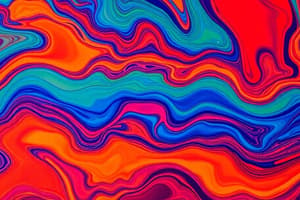Podcast
Questions and Answers
How does an increase in temperature affect the viscosity of a liquid?
How does an increase in temperature affect the viscosity of a liquid?
- Viscosity decreases. (correct)
- Viscosity increases.
- Viscosity remains unchanged.
- Viscosity fluctuates unpredictably.
What primarily influences the vapor pressure of a liquid?
What primarily influences the vapor pressure of a liquid?
- The color of the liquid.
- The surface area of the liquid exposed to gas.
- The intermolecular forces acting within the liquid. (correct)
- The amount of liquid in the container.
Which of the following statements about capillary action is true?
Which of the following statements about capillary action is true?
- It occurs only in narrow tubes.
- It depends solely on cohesion between liquid molecules.
- It is unrelated to the intermolecular attraction governing liquids.
- It results from the combination of cohesion and adhesion. (correct)
Which of the following best describes the relationship between vapor pressure and temperature?
Which of the following best describes the relationship between vapor pressure and temperature?
What is the molar heat of vaporization?
What is the molar heat of vaporization?
Which liquid has a stronger intermolecular force of attraction based on the given examples?
Which liquid has a stronger intermolecular force of attraction based on the given examples?
In an open container, how does water's vapor pressure compare to that of acetone at 25°C?
In an open container, how does water's vapor pressure compare to that of acetone at 25°C?
What role does adhesion play in capillary action?
What role does adhesion play in capillary action?
What is the effect of dishwashing liquid on the surface tension of water when a paper clip is placed on its surface?
What is the effect of dishwashing liquid on the surface tension of water when a paper clip is placed on its surface?
In the viscosity activity, which liquid is expected to empty from the cup faster when poured, oil or water?
In the viscosity activity, which liquid is expected to empty from the cup faster when poured, oil or water?
What phenomenon would be observed if you placed a paper clip on pure water, without any additives?
What phenomenon would be observed if you placed a paper clip on pure water, without any additives?
During the capillary action experiment with water and pechay baguio, what is expected to be observed initially at the start?
During the capillary action experiment with water and pechay baguio, what is expected to be observed initially at the start?
In the viscosity experiment, why is oil expected to take longer to pour out of the cup compared to water?
In the viscosity experiment, why is oil expected to take longer to pour out of the cup compared to water?
What can be inferred about the surface tension of water with the addition of a surfactant like dishwashing liquid?
What can be inferred about the surface tension of water with the addition of a surfactant like dishwashing liquid?
What is likely the reason for the difference in emptying times between the glasses containing oil and water?
What is likely the reason for the difference in emptying times between the glasses containing oil and water?
Which substance is likely to demonstrate capillary action effectively in this experiment?
Which substance is likely to demonstrate capillary action effectively in this experiment?
What is the expected outcome when pechay baguio leaves are placed in a jar of colored water overnight?
What is the expected outcome when pechay baguio leaves are placed in a jar of colored water overnight?
In an experiment measuring evaporation rates, how does the evaporation time of acetone compare to that of water?
In an experiment measuring evaporation rates, how does the evaporation time of acetone compare to that of water?
What is the primary purpose of trimming the bottom of the pechay baguio leaves in the experiment?
What is the primary purpose of trimming the bottom of the pechay baguio leaves in the experiment?
Which type of intermolecular force is mostly responsible for the different evaporation rates observed between water and acetone?
Which type of intermolecular force is mostly responsible for the different evaporation rates observed between water and acetone?
What is the significance of conducting the evaporation experiment in an area with direct sunlight?
What is the significance of conducting the evaporation experiment in an area with direct sunlight?
In the procedure involving food coloring and pechay leaves, what chemical process does this activity primarily illustrate?
In the procedure involving food coloring and pechay leaves, what chemical process does this activity primarily illustrate?
What would be a suitable method to conserve water at home based on the outcomes from the post-lab activity?
What would be a suitable method to conserve water at home based on the outcomes from the post-lab activity?
Which characteristic of water contributes most to its unique properties outlined in the activity?
Which characteristic of water contributes most to its unique properties outlined in the activity?
What term describes the substance that is dissolved in a solution?
What term describes the substance that is dissolved in a solution?
Which statement best describes a solution?
Which statement best describes a solution?
In the context of solutions, what does the term 'solvation' refer to?
In the context of solutions, what does the term 'solvation' refer to?
Which property influences whether two substances will form a homogeneous solution?
Which property influences whether two substances will form a homogeneous solution?
Which of the following best describes the role of the solvent in a solution?
Which of the following best describes the role of the solvent in a solution?
What is true about miscible substances in the context of solutions?
What is true about miscible substances in the context of solutions?
What is the typical physical state of a solution if the solvent is a liquid?
What is the typical physical state of a solution if the solvent is a liquid?
When substances are immiscible, what occurs upon mixing?
When substances are immiscible, what occurs upon mixing?
What is the total energy needed to melt 50 grams of ice?
What is the total energy needed to melt 50 grams of ice?
How much energy is required to raise the temperature of 250 grams of water from 25°C to its boiling point and then boil it?
How much energy is required to raise the temperature of 250 grams of water from 25°C to its boiling point and then boil it?
At -30 °C and 2000 kPa, which state is carbon dioxide in?
At -30 °C and 2000 kPa, which state is carbon dioxide in?
What is the critical point of CO2 in terms of temperature and pressure?
What is the critical point of CO2 in terms of temperature and pressure?
At the triple point of CO2, what phases coexist?
At the triple point of CO2, what phases coexist?
Which property must be observed to describe the appearance of a sugar solution?
Which property must be observed to describe the appearance of a sugar solution?
What is the heat of vaporization of water?
What is the heat of vaporization of water?
Which of the following statements about the states of matter is true?
Which of the following statements about the states of matter is true?
Study Notes
Viscosity
- Affected by temperature: as temperature increases, viscosity decreases.
- Increased intermolecular forces of attraction (IMFA) lead to higher viscosity.
- Viscosity examples:
- Water: 1 centipoise
- Honey: 10,000 centipoise
- Honey has greater IMFA compared to water.
Capillary Action
- Defined as the ability of a liquid to rise in narrow tubes or small openings.
- Also known as capillarity.
- Results from intermolecular attractions between liquid and solid materials.
- Two forces involved:
- Cohesion: attraction between like molecules (liquid molecules).
- Adhesion: attraction between unlike molecules (e.g., water and glass).
Vapor Pressure
- Pressure exerted by gas in equilibrium with a liquid in a closed container at specific temperature.
- Increases with temperature; independent of liquid amount or surface area.
- Increased temperature leads to increased vapor pressure; increased IMFA results in lower vapor pressure.
- Vapor pressure examples at 25°C:
- Acetone: 0.28 atm
- Water: 0.03 atm
- Acetone evaporates faster than water due to weaker IMFA compared to stronger hydrogen bonding in water.
Molar Heat of Vaporization
- Defined as the energy required to vaporize 1 mole of a liquid at a specific temperature.
Properties of Liquids
- Observations via practical activities to understand surface tension, viscosity, capillary action, and vapor pressure.
Surface Tension
- Explore effects of adding dishwashing liquid to water on the surface tension and whether a paper clip can float.
Viscosity Activity
- Compare the time it takes for water and oil to empty from a tipped cup to evaluate differences in viscosity.
Capillary Action Experiment
- Place food-colored water in a jar with pechay baguio leaves and observe color movement to understand capillary action.
Vapor Pressure Activity
- Measure evaporation times for drops of acetone and water on coins to assess differences in vapor pressure and evaporation rates.
Phase Diagram of Carbon Dioxide
- Identify states of CO2 at different temperature and pressure combinations using a phase diagram.
- Critical and triple points signify unique physical states of CO2 under varying conditions.
Physical Properties of Solutions
- Distinction between solute (substance being dissolved) and solvent (medium doing the dissolving).
- Solutions are homogeneous mixtures that can be gaseous, liquid, or solid.
- Solvation and hydration processes involve solute particles surrounded by solvent molecules.
- Miscibility indicates the ability of substances to form a single homogeneous phase; immiscible substances form separate phases.
Studying That Suits You
Use AI to generate personalized quizzes and flashcards to suit your learning preferences.
Related Documents
Description
Test your knowledge on the concepts of viscosity, capillary action, and vapor pressure in this quiz. Understand how temperature and intermolecular forces affect these properties of liquids. Explore real-world examples and definitions that illustrate these important principles of physics.



